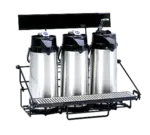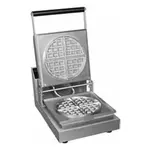
Is Breakfast Service Right for Your Restaurant? Key Considerations Before You Begin
- The Rising Popularity of Breakfast Service
- What Time Does Breakfast Start?
- Breakfast Ideas for Restaurants: The Power of a Strong Menu
- What is the Most Common Breakfast Service Used in Hotels and Restaurants?
- Restaurant Equipment Needed for Serving Breakfast
- Conclusion: Is Breakfast Service Right for Your Restaurant?
Expanding a restaurant's offerings to include breakfast can be an exciting prospect for many business owners. As breakfast becomes increasingly popular among various demographics, many restaurants are exploring the idea of incorporating this meal into their menu. But is adding breakfast service a smart move for your restaurant? There are several factors to consider, from logistics to customer demand and equipment investment. Let’s explore some key considerations when deciding whether your restaurant should start serving breakfast.
The Rising Popularity of Breakfast Service
The modern consumer’s relationship with breakfast has evolved significantly over the past few years. Breakfast has become a popular option not just in traditional cafes and diners but also in high-end restaurants, fast-casual spots, and even food trucks. This surge in interest is linked to a growing focus on health, convenience, and unique breakfast offerings. As more people look for quick, nutritious meals or indulgent breakfast treats, restaurants have a golden opportunity to tap into this trend.
However, simply deciding to add breakfast service isn't enough. It requires a strategic approach that includes understanding customer preferences, operational capacity, and the financial implications.
What Time Does Breakfast Start?

Timing is crucial when deciding to serve breakfast. Traditionally, breakfast service starts between 6 AM and 8 AM in most restaurants and hotels, catering to early risers, commuters, and travelers. However, some establishments choose to start serving breakfast later in the morning, around 9 or 10 AM, depending on their clientele. For instance, if your restaurant is located in a bustling city center with a lot of professionals, starting breakfast service earlier may make sense. Conversely, if your customer base leans more towards tourists or families on leisurely schedules, a later start might be more appropriate.
Who Still Serves Breakfast?
Restaurants that serve breakfast have long been a staple of the hospitality industry. Some well-known chains, like IHOP and Denny's, have built their entire business around all-day breakfast, while others, such as McDonald's, began offering breakfast later in their lifespan. Many independent restaurants, cafes, and hotels continue to recognize the value of breakfast service and offer it as a part of their daily operations. The key to success in this category is understanding who is still serving breakfast in your area and what they’re offering. Competitive research can provide insight into whether there’s a gap in the market that your restaurant could fill with a unique or superior breakfast menu.
Breakfast Ideas for Restaurants: The Power of a Strong Menu
Designing the perfect breakfast menu is central to a successful breakfast service. Some of the most common breakfast items served in hotels and restaurants include classics like eggs, pancakes, waffles, sausages, and coffee, but your menu doesn’t have to be limited to traditional fare. Depending on your restaurant’s style and target demographic, you can include healthier options like avocado toast, smoothie bowls, and plant-based breakfasts or cater to a more indulgent crowd with gourmet versions of classic breakfast dishes.
Offering breakfast all day has become an increasingly popular choice among restaurants, as it gives diners flexibility and can boost sales during non-peak hours. But what type of menu is used by a restaurant that serves breakfast all day? These menus tend to be versatile and compact, featuring a mix of standard and signature breakfast items. From hearty dishes like steak and eggs to light options like yogurt parfaits, an all-day breakfast menu should cater to a wide range of tastes and preferences.
What is the Most Common Breakfast Service Used in Hotels and Restaurants?
Buffet-style service is one of the most common formats for breakfast in hotels and large restaurants. This style allows guests to serve themselves from a variety of hot and cold dishes, such as scrambled eggs, pastries, fresh fruit, and cereals. Buffets are popular because they allow for fast service, which is especially important for travelers who need a quick meal before starting their day.
However, not all restaurants have the space or the demand for a buffet setup. Many smaller venues opt for à la carte service, where customers order their meals from a set menu. This model works well for establishments that want to focus on delivering high-quality, freshly prepared dishes and where diners are looking for a more relaxed breakfast experience.
Who Serves Breakfast All Day?
The growing popularity of breakfast has led many restaurants to experiment with serving breakfast all day. This approach is especially popular with diners and fast-casual restaurants, where customers expect a menu that offers a wide variety of meal options at any time of day. IHOP, for instance, is famous for its all-day breakfast, allowing customers to enjoy pancakes, omelets, and other breakfast staples whenever they want.
If you're considering offering breakfast throughout the day, it's important to assess whether this fits with your restaurant’s concept and clientele. Some restaurants find that offering breakfast alongside lunch and dinner adds operational complexity, while others embrace the challenge as a way to increase customer satisfaction and stand out in a crowded market.
What Type of Menu is Used by Restaurants That Serve Breakfast All Day?
Restaurants that serve breakfast all day tend to keep their menus simple and efficient. These menus usually focus on breakfast staples that can be prepared quickly, such as eggs, bacon, toast, and pancakes, but they often include customizable options that allow customers to mix and match ingredients. For instance, a diner might offer a “build-your-own omelet” section, where guests can select their preferred fillings.
Another common feature of all-day breakfast menus is portability. With the rise of takeout and delivery, many restaurants have adapted their breakfast offerings to include handheld items like breakfast burritos, sandwiches, and wraps, making it easier for customers to enjoy breakfast on the go.
Restaurant Equipment Needed for Serving Breakfast

Starting a breakfast service requires not only menu planning but also a careful assessment of the equipment you’ll need. Breakfast service often involves specific equipment that you might not already have if your restaurant currently focuses on lunch or dinner. Here are some essential pieces of equipment to consider:
- Griddle or Flat Top: Ideal for cooking pancakes, eggs, and breakfast meats like bacon and sausage. A griddle allows for the efficient preparation of multiple items at once.
- Commercial Toaster: A high-volume toaster is essential if you plan to offer toast, bagels, or English muffins.
- Coffee Machines and Espresso Makers: Breakfast service often revolves around beverages, with coffee being a staple for most customers. High-quality coffee equipment can make a significant difference in customer satisfaction.
- Juicers and Blenders: With the rise of healthy breakfast trends, offering fresh juice or smoothies can be a great way to stand out. Investing in a durable juicer and blender will help you meet customer demand for these items.
- Waffle Irons and Pancake Dispensers: If your breakfast menu includes waffles or pancakes, you'll need specialized equipment to ensure consistency and quality.
- Refrigeration and Storage: Eggs, dairy, and fresh produce are essential ingredients in most breakfast dishes, so having adequate refrigeration space is crucial. You may also need additional storage for dry goods like cereal, flour, and oats.
By investing in the right equipment, you can ensure that your restaurant is ready to handle the unique demands of breakfast service efficiently.
Who is Still Serving Breakfast?
Breakfast isn't just for traditional diners and cafes anymore. As breakfast continues to grow in popularity, even fine dining restaurants are beginning to add breakfast or brunch options to their menus. Fast-food chains, too, have recognized the power of breakfast, with brands like Chick-fil-A and Wendy’s now offering breakfast service. Understanding who is still serving breakfast in your area can help you position your restaurant effectively. If your competitors are offering breakfast, it’s worth considering how you can differentiate your menu and attract a loyal customer base.
Conclusion: Is Breakfast Service Right for Your Restaurant?
Deciding to start serving breakfast can open up new revenue streams and attract a broader customer base. However, it’s essential to carefully weigh the pros and cons before making this decision. Consider your restaurant’s location, customer preferences, operational capacity, and the investment required for equipment and staffing. By thoughtfully planning your breakfast service, from menu development to the timing of service, you can create a successful new offering that enhances your restaurant’s brand and increases profitability.
Breakfast may be the most important meal of the day, and with the right strategy, it could become one of the most important additions to your restaurant’s business.





